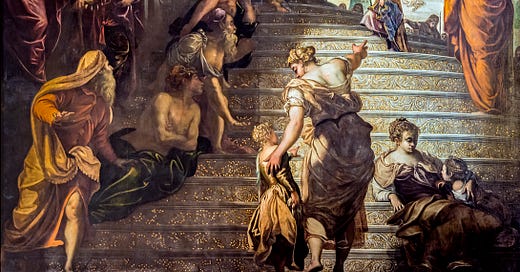5. Il Rinascimento Veneziano con Tintoretto
Transcending reality and perceiving the miracle: sensory mystery in Tintoretto's theatrical Renaissance
Dear readers and lovers of the Italian language and culture,
Welcome to the fifth chapter in a series of readings in Italian designed to guide you through the Venetian artistic contributions during the Renaissance while practising the language.
Today, we stay in the city of Venice and explore how, during the central and late years of the 16th century, a new concept of reality comes to life in the phantasmagorical paintings of Tintoretto. Unlike the pagan and Platonic inspirations that shaped the idyllic Venetian mainland through the visual contributions of Giorgione and Titian, Tintoretto leads us into a more contrasted universe, where the sacred merges with miracles, appearing with the artificious power of a theatrical set. By analysing his art, we can better understand the historical context in which Tintoretto worked, that was profoundly tied to Venetian institutions and the emerging spirituality of the Counter-Reformation.
Reading Level: B1-B2
Challenges: philosphical content
Una visione tormentata del tardo Rinascimento veneziano
Dopo aver esplorato l’estetica rinascimentale riflessa nella campagna veneziana, carica di colori e di elementi profani, ora torniamo nell’isola di Venezia. Osserviamo con gli occhi del pittore Jacopo Robusti, chiamato Tintoretto, un universo simbolico molto diverso che evoca una spiritualità lacerata da luci e ombre e fortemente legata al tessuto sociale e istituzionale della città e alla nuova ideologia della Controriforma.
Tintoretto nasce a Venezia nel 1519 e ci rimane per tutta la vita. Il nome con cui lo conosciamo deriva dalla professione del padre, un ‘tentor’ cioè un tintore di tessuti. Diversamente del suo maestro Tiziano, viaggia pochissimo e concentra la sua attività artistica nella città lagunare alla quale lascia una grandissima quantità di dipinti. Troviamo opere di Tintoretto in tantissime chiese dell’isola, ma in due luoghi particolari possiamo contemplare la sua arte in modo unico e assoluto: la Chiesa della Madonna dell’Orto e la Suola Grande di San Rocco.
Oltre l’equilibrio classico
Keep reading with a 7-day free trial
Subscribe to Italian Inspirations to keep reading this post and get 7 days of free access to the full post archives.





